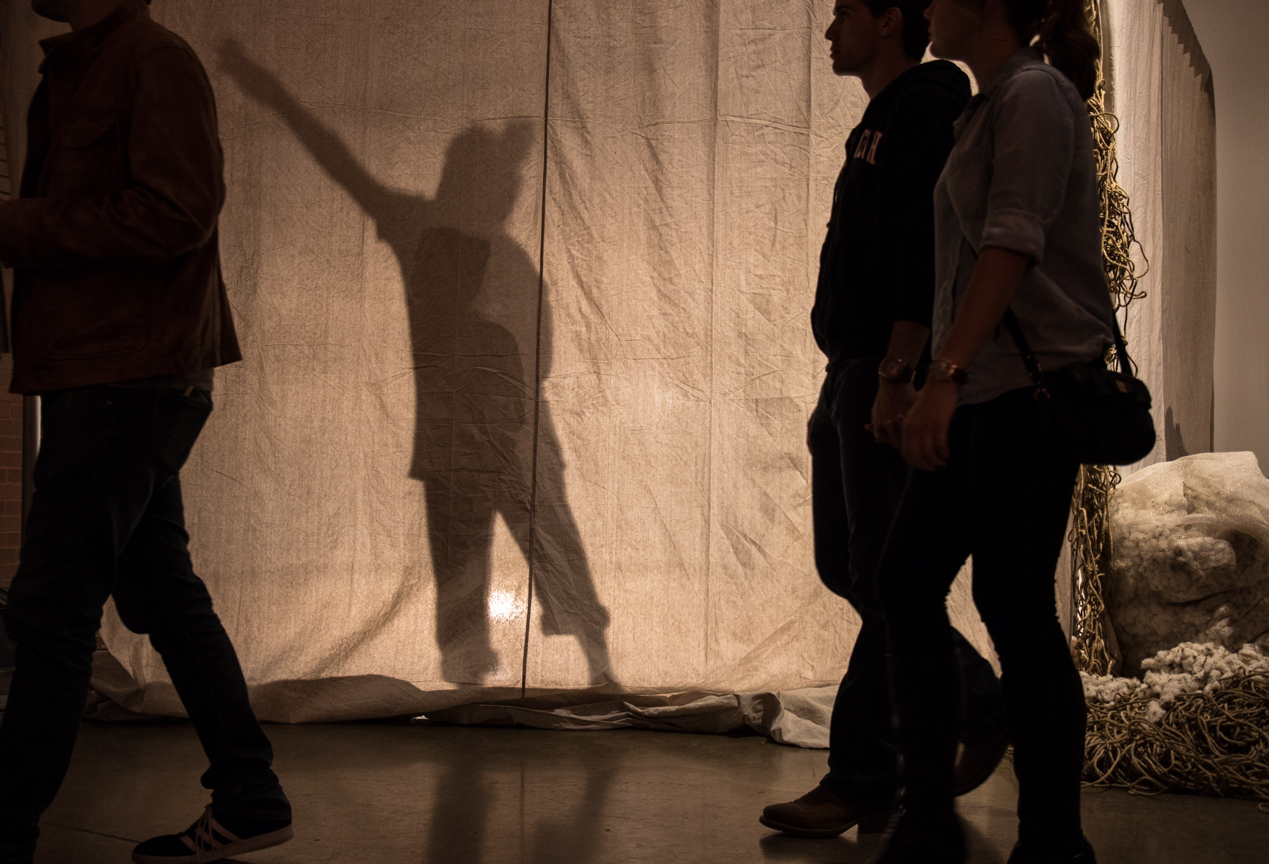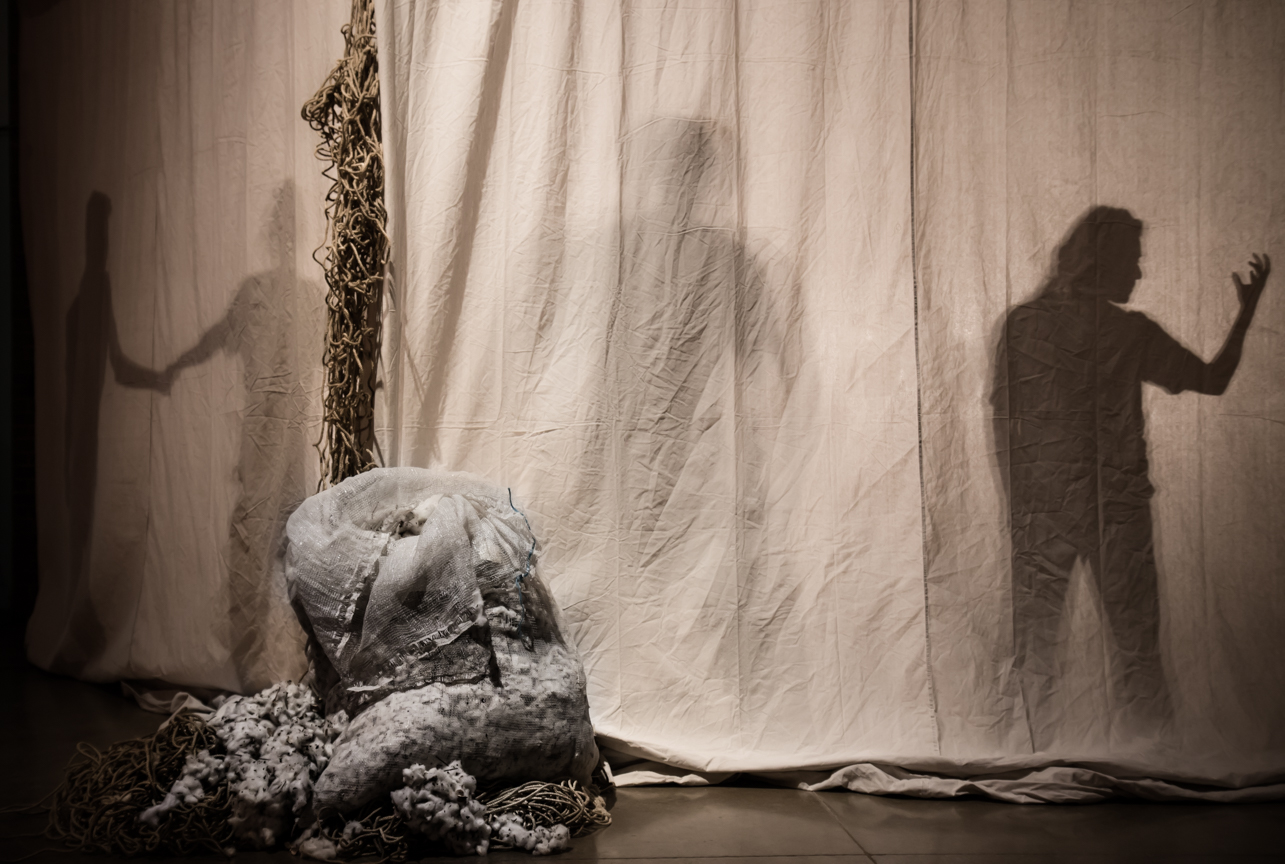JARED T. STANLEY
LUBBOCK: LIFE OF COTTON
I N T E R D I S C I P L I N A R Y A R T S P R O J E C T G R A N T
C O L L E G E O F V I S U A L A N D P E R F O R M I N G A R T S | T E X A S T E C H U N I V E R S I T Y
Cotton has long been an agricultural staple in the plains of West Texas. The arduous process of producing cotton has brought generations of individuals from different cultures together. While cotton production is typically associated with the machinery owned and worked by local farmers, Lubbock and other West Texas cities have another history not often remembered and honored—the story of the migrant laborers who came to work in the United States from Mexico. These migrant workers played an integral role in cotton production, as they travelled seeking work and opportunity, especially during the 1940s and 1950s when the Bracero Program was instated nationally.
This installation explores our relationships with cotton and the plight of the migrant workers through audio stories, sensory poetry, live performance, video and sculpture. Our goal is to encourage community storytelling.
Durante mucho tiempo, el algodón ha sido un producto agrícola esencial en las llanuras del West Texas. El proceso duro de producción de algodón ha unido generaciones de individuos de diferentes culturas. La producción de algodón se asocia típicamente con los agricultores locales que recogen el algodón con maquinaria. Pero, Lubbock y otras ciudades del West Texas tienen otra historia que no es recordado y honrado—la historia de los trabajadores migrantes que vinieron a trabajar en los Estados Unidos de México. Estos trabajadores migrantes eran un parte importante en la producción de algodón, cuando viajaban en busca de trabajo y oportunidades, especialmente durante los años de1940 y 1950 cuando el Programa Bracero fue establecido a nivel nacional.
Esta instalación explora nuestra relación con algodón y la difícil situación de los trabajadores migrantes a través con historias de audio, poesía sensorial arte de desempeño, video y escultura. Nuestro objetivo es animar a nuestra comunidad para contar historias.
ARTISTS
EVANGELINE JIMENEZ | CREATIVE WRITER
KATHRYN KELLEY | INSTALLATION ARTIST
ASHLEY MEYER | PERFORMANCE ART
JARED STANLEY | CONCEPT DESIGN
& INTERMEDIA ARTIST
SPECIAL THANKS TO
TTU CVPA & Seth Warren-Crow , Dr Heather Warren Crow , Dr Andy Gibb, Dr Bob Chanda , Dr David Forrest | Texas Tech University Southwest Library Oral Collection | Texas Tech University Plant & soil Science | Crossroads Recording Studio | Smithsonian Museum | Latino Lubbock & Christy Martinez |
LHUCA & Linda Cullum, Andrew Carrizales | Jerome & Cindy Kristinek | Alicia Caicedo-Cavazos, Greg Cavazos, Rosalinda Ramirez & Roman Ramirez, Mario Ybarra, Dr Rosalinda Jimenez, Adrian Jimenez | Performers : Alec Gallardo, Matthew Cubillos, Bailee Tanguma, Virginia Fuentes, Nicole McIntyre | Local Interviewees
Lubbock: Life of Cotton – La Vida de Algodón
October 7 – November 26, 2016
Louis Hopkins Underwood Center for the Arts
Review by Lindsey Maestri
When you grow up in Arkansas, West Texas is not what you picture when someone says cotton. You imagine the Delta; southern Arkansas, Mississippi, Louisiana, maybe even parts of Alabama, but not West Texas. You picture a Pre-Civil War South with plantations and slavery followed by poor sharecroppers. You hear Lead Belly singing Cotton Fields.
Lubbock: Life of Cotton – La Vida de Algodón altered my personal narrative of cotton and presented me with a chapter in the agricultural staple’s history I had not considered. This four person collaborative exhibition at the Louis Hopkins Underwood Center for the Arts (LHUCA) features the work of Evangeline Jimenez, Kathryn Kelley, Ashley Meyer, and Jared Stanley. Together the group explores cotton’s history through the eyes of Mexican migrant workers of the 1940s and 1950s brought to the United States during the Bracero Program, a now debunked program that helped fill a mid-century agricultural labor shortage.
As the viewer enters the gallery at LHUCA, one thing is immediately clear, there is a diverse range of skill sets at work here. Video, audio from multiple sources, sculpture, live performance, and text and imagery in the form of three printed books all accompany the exhibition – possibly a bi-product of having intermedia artist Jared Stanley on board.
Faint, scrolling videos of cotton fields with fingers plucking the white fluff from ridged bolls project high and wide across one entire wall of the space. A giant fiber-based sculpture hangs from the high ceiling, occupying nearly one quarter of the gallery. Alternating male and female voices playing from speakers repeat the same mantra in Spanish, “Pisca, Bolsa, Pisca, Bolsa,” then English, “Pick, Bag, Pick, Bag.” Sixteen long cotton sacks stretch from hooks mid-wall onto the floor, reinforcing the weight of their heavy task. Three headsets hang evenly spaced between the sacks and tell stories of American dreams and bloodied hands.
During the live performance, several of the long cotton sacks were removed from the wall and slung over the shoulders of five male and female performers. They then metaphorically entered the field and got to work. Some mimed the delicate act of picking while others used exaggerated gestures of heaving and dragging or pushed faux cotton bails around the gallery. Their movements throughout the crowd of viewers were purposeful yet aimless. As they worked, they periodically murmur phrases or recited monologues aloud. Ashley Meyer scripted the two-hour performance, and her performers did a wonderful job of holding up.
While the large-scale sculpture of Kathryn Kelly sets a visual structure for the exhibition, it is a little less obvious how it fits into the more literal written words, images, audio and actions formatted by the other three collaborators. That is not to say that her work isn’t impressive, because it is. Kelley has erected an enormous, two storied, cone shaped sculpture that hangs from the ceiling of the gallery. The outside is constructed of long, stuffed fabric tubes that have been faceted together to create a hollow cornucopia lined in raw, unbleached cotton. I can sense its loose connection to the cotton warehouse facilities scattered along the outskirts of Lubbock with their industrial shoots piping freshly harvested cotton into multistoried piles. Kelley is also responsible for the faux stacks of bailed cotton, which possess the same tactilely inviting quality of the massive cotton cone.
Language, both written and spoken, plays a significant role in this exhibition. Evangeline Jimenez, the creative writer in the collaboration, penned a number of elegantly descriptive sensory poems that can be found in various forms throughout the show. Every piece of audio and text, down to the vinyl statement on the wall, is presented in both Spanish and English. This consideration, thoughtfulness, and respect for the subjects of the artists’ concept was refreshing to say the least.
By retelling the shared history of West Texas cotton production and the Mexican migrant worker of the 1940s and 1950s, Lubbock: Life of Cotton – La Vida de Algodón asked us to consider our relationships with cotton, a request that was met by this viewer.
photography courtesy of jared t stanley











